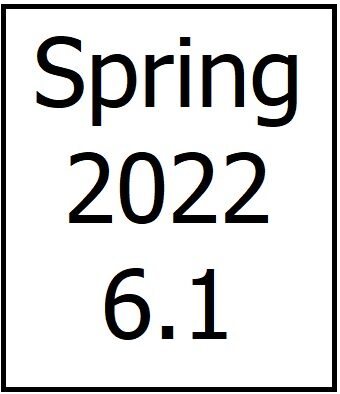Greta Thunberg in Social Media: A Representation of the Racial Disparity in Environmentalism
Malori Malone, University of Florida
Introduction
The dramatic rise of social media in the past decade has ushered in one of the largest waves of activism for environmental conservation, and at the forefront of this movement stands an eighteen-year-old girl from Sweden: Greta Thunberg. Thunberg’s (then fifteen) iconic story begins on August 20, 2018, when she decided to skip school and protest outside Swedish Parliament. The message on her cardboard sign: School Strike for Climate Change. In the years since, her voice has risen past the borders of her country, and turned into a global uprising. I believe the reasonings for her illustrious fame go deeper than simply her age. I think social media has had a tremendous impact on the rapid spread of Thunberg and her messages.
In addition, when we look at the positive implications climate change movements like Thunberg’s have, I think it is significant to analyze the individuals who are excluded from the forefront image. Has white privilege affected Thunberg’s rise to fame? Do race and gender play into this recipe for social media success? More importantly, are young men and women of color underrepresented in these movements? By combining Intersectional Feminism and Environmental Justice Theory, the purpose of my research is to analyze the racial and environmental global implications that arise from social media movements like Thunberg’s.
Spreading Environmental Activism to Youth Around the World
In just a few years, Thunberg’s call for environmental change and the dire need for immediate action has spread to future generations at an increasingly high frequency. For example, groups like “Fridays for Future” were conceived from her message. While Thunberg may have ignited the spark which catapulted thousands of other young people around the world to advocate for climate change, branched-out organizations continue to carry her torch. Girls and boys throughout the world are sacrificing their time in school for the future of the planet; their reasoning: “We strike because we have no choice. We are fighting for our future and for our children’s future. We strike because there is still time to change, but time is of the essence. The sooner we act, the better our shared future will be” (Fridays for Future, 2022). With social media as their active transport, this group of young adults is given a megaphone to broadcast their voice throughout the world. More specifically, “Social Media presents an opportunity to voice one’s concerns about climate change and the need for action, as well as document the discontent among citizens by posting pictures for protest events” (Boulianne et al., 2020, p. 211). In terms of global collaboration, social media provides a stellar channel for young adults around the world to broadcast their call for legitimate change.
Social Media’s Climate Change Star
Since her first school strike in late 2018, Thunberg has become a climate change superstar through the vessel of social media. Her tangible environmental activism has created massive climate change trends throughout the online universe. For instance, “Twitter as a platform, was used by the leader of the School Strike 4 Climate, Greta Thunberg. Her tweets were widely circulated, liked, and commented upon” (Boulianne et al., 2020, p. 216). Thunberg wielded her sword of influence past the steps outside her school. Using social media, she created a virtually global discussion around youth advocating for climate justice. A 2020 study of Thunberg’s social media activism, covered by Shelley Boulianne, Mireille Lalancette, and David Ilkiw, dove deeper into the substance of Twitter messages that resulted as a by-product of Thunberg’s activism. Among the tweets collected, they found that
[a]side from Greta Thunberg’s tweets, every tweet used as an example included a mention of ‘students,’ ‘youth,’ ‘young,’ and ‘school girl.’ These examples represent the larger database of tweets, which included many mentions of these concepts as well as many @GretaThunberg references. In the larger database of 13,542, the word ‘students’ appeared 33,000 times and @GretaThunberg appeared 20,000 times. (p. 216)
It wasn’t necessarily just Thunberg’s tweets that catapulted her fame in the social media spotlight, but rather, it was the results of others using her name as a catalyst for climate change. But why was Thunberg’s voice specifically put on social media’s loudspeaker?
Racial Disparity in Environmentalism
Racial disparities are key channels to focus on when analyzing the inferences that arise from social media movements like Thunberg’s. The ingredients which created an activism star like Thunberg are more complex than just her youthfulness and resilient message. Carolyn Beeler states, “The environmental movement, overall, has been criticized for being too white for a long time” (2019, p. 1). The factor of Thunberg’s white privilege is arguably one of the main reasons as to why the media has latched onto her as a focal point of the climate change movement. Joe Curnow (2019) from the University of Manitoba says, “So, I’m like, why Greta? And I think that has a lot to do with questions of race and racism. I think her whiteness is very much an asset for why the media, why governments, why the UN has been willing to feature her” (p. 1). With Thunberg as the face of climate change, many argue that we should be more concerned with giving environmentalism the global profile it so crucially needs, rather than focusing on through who specifically. However, with minority groups normally in the first line of assault within environmental impacts, shouldn’t they be given a similar spotlight for activism input?
Yet, the existing racial inequality within environmental activism is not due to a lack of effort from youth of color, but rather the constraints placed on their voices. Therefore, “[w]hile a great deal of research has examined how the neighborhood environment affects youth, less has focused on how individual young people perceive, engage with, and ‘make meaning’ of neighborhood-level environmental disparities” (Teixeira & Zuberi, 2019, p. 1). A Pittsburg Research institute showed areas of racial inequality are the first to suffer the consequences of pollution and environmental destruction. Yet, the opinions of the young individuals impacted in these environments are the last to be recognized. In a study of youth perception of environmental impact in African-American Communities, they found that “the youth were attuned to environmental inequities and expressed frustration about the lack of response to litter and dumping by the city and adults in their community” (p. 7). It is evident there is a significant disparity between the representation of white, upper-class voices like Thunberg’s and those of lower-class youths of color, which in reality, face most of climate change’s fallout.
Intersectional Feminism
The need for a conceptualized term to describe the intersection of race, gender, education, class, culture, ethnicity, language, and sexuality arose in the past few decades. Eventually, the terminology of Intersectional Feminism Theory was born. The founder of the term, Kimberlé Williams Crenshaw described the objective: “to illustrate that many of the experiences Black women face are not subsumed within the traditional boundaries of race or gender discrimination as these boundaries are currently understood, and that the intersection of racism and sexism factors into Black women’s lives in ways that cannot be captured wholly by looking at the women’s race or gender dimensions of those experiences separately” (Jackson 2019, p. 40). Although its meaning has been visible for centuries, this theory provides a significant interpretation of the idea that gender and race do not exist in bubbles of their own in our society. Unlike White Feminism (the popular theory in circulation), Intersectional Feminism seeks to include the viewpoints of all women, regardless of their background. Intersectional Feminism is a step beyond White Feminism, since “White feminists are often unaware of and unwilling to admit their privilege within the feminist movement, which alienates and ignores women who, for whatever reason, fall outside of the cookie-cutter binary” (Brennan, 2019, p. 22). Simply put, Intersectional Feminism pursues the inclusion of the components White Feminism fails to highlight.
Intersectional Feminism has been applied to research projects across a myriad of social media platforms. For instance, on Twitter, hashtags like #FastTailedGirls and #SayHerName were created with the theme of Intersectional Feminism, the theme that seeks to explain the idea of how various elements outside just race and gender intersect to impact women. These discussions connect marginalized groups and give a voice to the voiceless. Thus, “Black women using the hashtag also expressed catharsis in being able to share their stories, and began a conversation for shifting communal norms. Actress Reagan Gomez-Preston offered, ‘If we don’t stick up for our girls, and stop blaming them for the actions of grown men, who will? SMH. #FastTailedGirls’” (Jackson et al., 2020, p. 40). In other words, in a world where minorities (especially young Black women) still struggle to be heard, digital platforms provide a space in which individuals can connect and share meaningful messages.
These hashtags steeped in Intersectional Feminism Theory are increasingly significant to recognize as visual markers which represent racial disparity in social media. Social media has been a great receptacle for discussions specially geared around Intersectional Feminism, but even in instances where it is not explicitly discussed, we can use it as a lens from which to analyze other situations on social media. For instance, in this research case of Greta Thunberg, who has experienced a magnitude of digital fame, we can use intersectional feminism as a means of analyzing which voices are being excluded and how that exclusion is being discussed on social media.
Environmental Justice
Environmental Justice theory is centered around the idea that justice and equality in the natural habitats we exist in are also connected to overall social justice. How we treat the environments of individuals in communities of racial or class disparities should not be unequal to how we address the environments of others. Yet, Environmental Justice goes even further than just race: “Environmental Justice draws on a civil rights framework and recognizes the relationship between race, place, space and the distribution of resources and hazards. Increasingly, research using an EJ framework has expanded to go beyond examining race and class to incorporating intersecting identities and multiple dimensions of inequality, including, for example, age and gender” (Teixeira and Zuberi, 2016, p. 3). In other words, EJ is about the meaningful involvement and support of those from all backgrounds and communities, regardless of race, gender, class, etc.
Method
Over a span of five weeks, I plan on combing through the social media platform Instagram for posts related to this discussion on youth environmental activism. Using the specific lenses of Intersectional Feminism and Environmental Justice theory, I plan to cultivate a series of messages, pictures, and content that will better help me understand what the conversation surrounding this topic looks like.
Methodology
After careful consideration, I plan to combine the methodologies of Environmental Justice and Intersectional Feminism theory to provide a more concrete conceptualization of my research. Intersectional Feminism is the accumulation of intersectional principles of gender, ethnicity, race, education, sexuality, language, class, and culture. This methodology seeks to link these related ideas back to women’s equality, and feminism. The theory of Environmental Justice reflects our obligation as a society to pursue the preservation and protection of all our natural communities, especially those surrounding racially marginalized ones.
By interlocking these two theories to create a double-layered lens, I hope to create a more in-depth understanding of this discussion surrounding Thunberg’s presence on social media as an environmental activist. Furthermore, this research will provide some enlightenment to the following questions: How does intersectional feminism influence the discussion of environmental activism? More importantly, if social media is in fact excluding certain groups from the discussion and pursuit of environmental justice, will these digital platforms in turn make it increasingly harder to maximize efficiency for the climate change cause? My last question I hope to answer is, Is Greta herself an intersectional feminist? Furthermore, does she recognize the segregation of ideas in this movement, and if so, in what ways does she combat the racial disparity?
Section 1: Greta Thunberg’s Influence on Social Media
The purpose of this research article is to organize information from social media to form a mental picture of what the digital conversation around environmentalism looks like. More specifically, how environmentalism consists of many different ideas and voices, and which voices are receiving more attention than others. For instance, climate change activism has centered much of its focus around Thunberg in the past few years. Posts such as Exhibit A reveal the large scale of Greta’s presence on social media and simultaneously, the world.
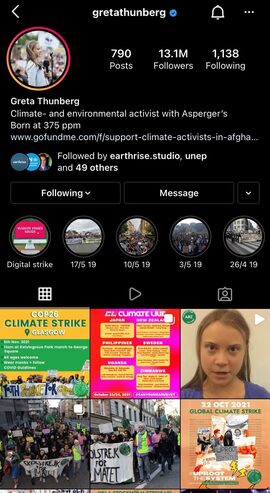 |
| Exhibit A |
With over 13 million followers, she has become an internet sensation for climate change. Such an intense following is sure to lead to implications for the reasons behind her fame, besides her age and message. Some could argue that her race and class have given her an advantage in the social media sphere. How many other young climate change adults are trending as increasingly as #GretaThunberg? Not many. With nearly 600k posts including this hashtag, her name is widely more publicized than any climate change activist of color. Yet, even in light of the idea that Thunberg’s race and class may have influenced her social media success, I think it's significant to notice that she still recognizes the importance of diversity within the movement she represents. For example, in Exhibit B and Exhibit C (next page), we can see her representation of climate change activism working in hand with individuals from Black and LGBTQ+ communities. However, as a side note, I believe it’s important to note that the climate change activist mentioned in Thunberg’s reposting of Time Magazine, Vanessa Nakate, has only 158k followers on Instagram. This kind of visual inclusion is important to recognize as it shows her awareness of diversity within the movement. It is posts like these that lead me to believe that Thunberg, despite the privilege of her race and class, is still an intersectional feminist herself—due to the heterogenous nature of her social media postings.
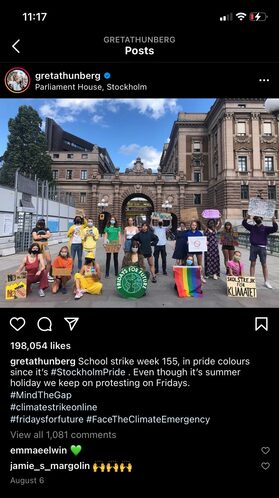 |
|
Exhibit B |
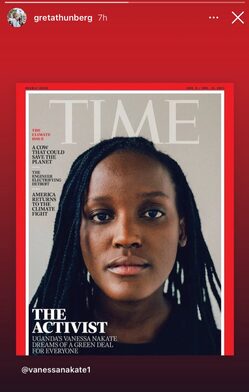 |
|
Exhibit C |
Section 2: Intersectional Feminists Advocate for Climate Change
Individuals from a myriad of minority groups have attempted to respond in any way possible to aid the Climate Change movement. Although they may be denied a voice within political spheres, social media supposedly provides a voice for anyone, regardless of their racial background. Individuals who identify as Indigenous, African-American, and Latinx have responded to the climate change scourge using social media as a means of global collaboration for tangible impact. For instance, pages like @intersectionalenvironmentalist work towards instilling a more diverse discourse surrounding climate change. Their Instagram biography page reads: “A climate change justice community and resource hub centering BIPOC and historically excluded voices,” followed by the hashtag: #TheFutureIsIntersectional. Upon clicking this hashtag, I found over five thousand posts containing the identical wording: #thefutureisintersectional (Exhibit D).
Further research showed me this message linked the common themes of not only intersectionality and climate change but women’s rights and feminism as well. While the majority of postings were not always specifically related to climate change, they did display support for diverse females in positions of influence. Similar to the support social media gave Thunberg, this hashtag reinforces the conversation of empowering women to create tangible, positive change. For instance, posts using this hashtag such as the one shown in Exhibit E represent the overlap between climate change activism and feminist activism. Over colorful flowers, a black and white banner says, “Destroy the Patriarchy Not the Planet.” The post description from @activist.ash reads, “We had a day of alright air today. Not good, but alright…. But as the toxic air rolls back in, I’m just going to leave this here…never forget that environmental issues are feminist issues, and women/gender diverse folk will adversely experience the impacts of the climate crisis (just in case we need another reason to revolt.” This shows the significant intersectionality of movements that incorporate messages of feminism, diversity, and environmental justice into a signal posting. Furthermore, this research supports the claim that this discourse for inclusivity within environmental justice is very much alive and breathing.
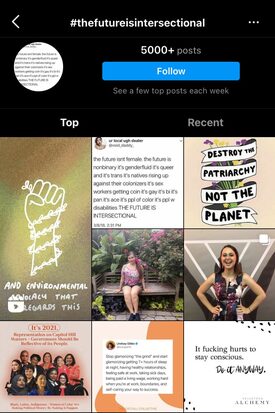 | 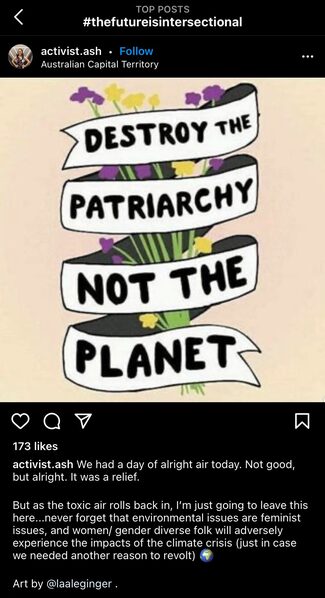 |
|
|
Exhibit D | Exhibit E |
Section 3: Why Does Intersectionality Matter within Environmental Justice?
An important addendum to this research is the significance of intersectionality in the spheres of environmental justice. While social media pages like @interesectionalenvironmentalist are prevalent on platforms such as Instagram, they are still undercut drastically when compared to the attention that Thunberg receives. As of December 2021, @intersectionalenvironmentalist has over 400,000 followers, yet Thunberg’s Instagram weighs in at a staggering 13.9 million followers. This gap between the face of one girl and the countless voices of minorities represents the lack of diversity and intersectionality within the climate change movement. Unfortunately, this means significant ideas and solutions to local and global issues have the potential to be overlooked in light of a more popular image (that of Thunberg). Social media posts such as the one in Exhibit F highlight the distinct issues that arise within the broad conversation of Environmental Justice. More specifically, aspects such as investing in African- American and Latinx communities, the accountability of corporations, Indigenous land rights, and affordable green housing signify the intersectional issues that must be addressed in order to prevent the deterioration of environments. Furthermore, examples such as Exhibit G exemplify the necessity for Brazilian Indigenous voices at the CHOOSE EARTH campaign. The post from Alice Aedy reads, “Meet the Real Climate Change Leaders. If biodiversity is nurtured by [I]ndigenous communities, why aren’t they given a seat at the table?”
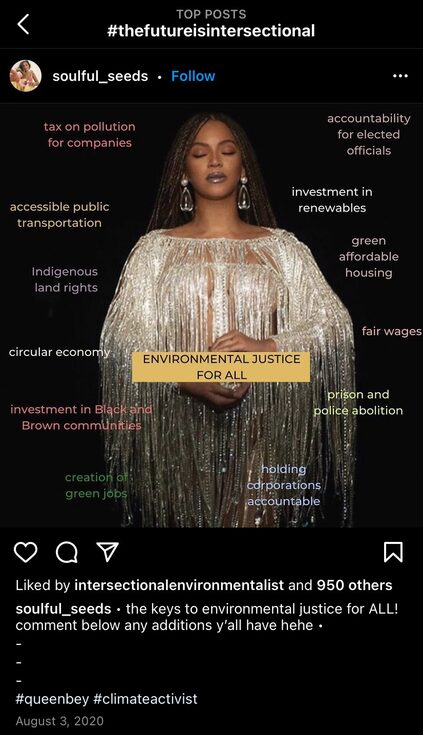 | 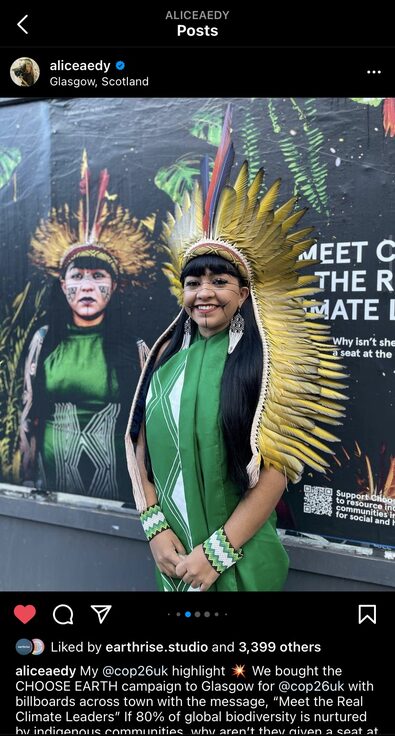 |
|
| Exhibit F | Exhibit G |
Conclusion/Implications
It is apparent Thunberg exists as an icon on and off social media. Her activism for a safer, healthy planet has landed her millions of followers. Yet, her fame brings to light how certain individuals are missing from the vital conversation on how we solve this impending global concern. How we neglect minority groups from this discourse will have a lasting impact on generations to come. Social media does provide a platform for youths of color to advocate change, but based upon the large gap of followers between their ideas and Thunberg’s, they are deprived of equal environmental representation and accommodation. Even Thunberg’s own awareness of the lack of intersectionality is not enough. We must expect more from the images and messages amplified through social media. Inclusivity is not negotiable a facet when it comes to saving our planet.
While this research shines an introductory light onto the conversation of Environmentalism in social media, it does not fully encapsulate the depth of racial disparity within. It is my hope that my initial research findings can further lead the way into a more in-depth, quantifiable research study into this issue. Due to the fact I was only able to focus on a limited series of postings, there is a certain lack of quantitative research. Through the use of web-scraping, a more detailed analysis could display a substantial number correlating to the environmentalism-diversity gap. If we could place a tangible percentage to the number of posts circulating not only Instagram, but other social media platforms as well (such as Twitter and Facebook), we could further solidify the evidence that intersectional factors such as race, gender, and class affect social media amplification. Furthermore, I believe a deeper investigation into the voices behind the screen could draw out qualitative data which may have been overlooked within this research project. By listening to the individual experiences of those neglected in this global movement, we can achieve a much clearer image of how racial disparity within social media incapacitates the global enterprise for climate change.
References
Beeler, C. (2019, October 10). How did teen climate activist Greta Thunberg rise to fame so quickly? The World from PRX. https://www.pri.org/stories/2019-10-10/how-did-teen-climate-activist-greta-thunberg-rise-fame-so-quickly
Boulianne, S., et al. (2020). “School strike 4 climate”: Social media and the International Youth Protest on Climate Change. Media and Communication, 8(2), 208-218. https://www.cogitatiopress.com/mediaandcommunication/article/view/2768
Brennan, C. (2019). White feminism falls short. ESSAI, 17, 20-23. https://dc.cod.edu/essai/vol17/iss1/13
Fridays For Future. (2022). https://fridaysforfuture.org/
Jackson, S., Bailey, M., & Welles, B. F. (2020). #Hashtagactivism: Networks of race and gender justice. MIT Press.
Teixeira, S., & Zuberi, A. (2016). Mapping the racial inequality in place: Using youth perceptions to identify unequal exposure to neighborhood environmental hazards. International Journal of Environmental Research and Public Health, 13(9), n.p. https://www.ncbi.nlm.nih.gov/pmc/articles/PMC5036677/#sec1-ijerph-13-00844title
